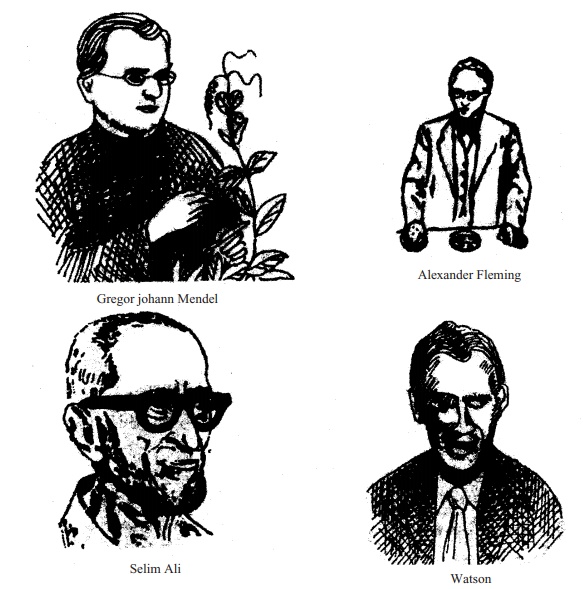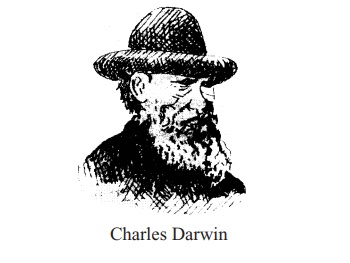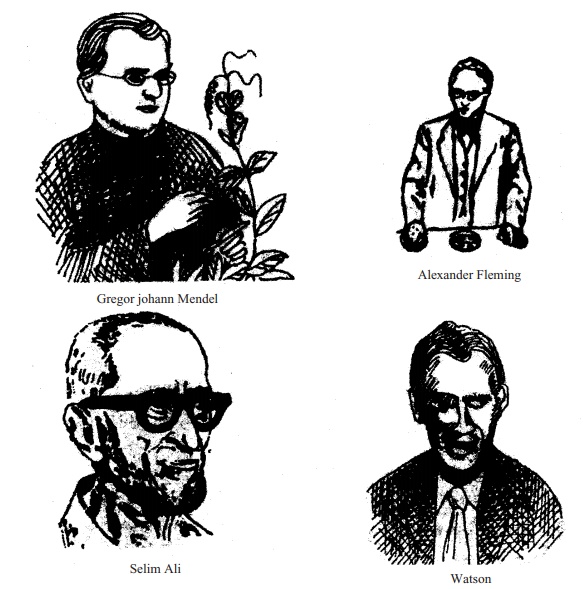Chapter: Biology: Introduction to Biology
Great scientists in Biology

Biology is the result of research and thinking of some
great scientists. This chapter introduces you with some of these scientists.
Aristotle (384-322
B.C): The great Greek
scientist, Aristotle is regarded as thefather of Zoology. He first established
Zoology as a branch of Science. Aristotle was simultaneously a scientist, poet,
thinker and philosopher. It is he who first mentioned about the basic
similarities in the structure of plants and animals. He stayed in an island
named Lesbos for five years continuously and made research on animals. He wrote
a book on animals and named it "Historia animalium" which is full of
information and knowledge.
Theophrastus
(370-285 B.C.): Little amount of
works of the Greekphilosopher Theophrastus is known to us. Of those available,
nine volumes of "On the History of Plants" and six volumes of
"On the causes of plants" are important. Theophrastus was the pupil
of great philosopher Aristotle. He divided the plant community into four
groups. For example: Trees shrubs, Undershrubs and Herbs. He is regarded as the
Father of Botany.
Al Biruni
(973-1048): Known as an world
famous scientist and educationist.Al Biruni was an Arabian citizen. His real
name is Abu Raihan Mohammad Ibne Ahmed Al Biruni. He made contributions in
different branches of science. He visited India during the reign of Sultan
Mahmud of Ghazni and described the conditions prevailing in India in an
attractive way.
Ibne Sina
(980-1037): He was a renowned
Muslim philosopher and scientist.He had excellent skill in Chemistry, Medicine,
Mathematics, Astronomy and Literature. His full name is Abu Ali Hussain Ibne
Abdullah Ibne Sina. He composed more than hundred books on different subjects.
Sixteen of which were written on Medicine. He had a fourteen volume
compositions named Al- Kanun' on
Medicine.
A1 Nafis: He was an Arabian scientist. He first (300 years before
WilliamHarvey) described correctly the system of blood circulation in human
body. He was also a successful physician. His actual name was Abu Al Hasan Ali
Ibne Al Nafis, He dedicated himself in the field of science for a long time,
and died in Damascus at the age of eighty.
William Harvey
(1578-1657): William Harvey was
a British scientist. Herediscovered the system of blood circulation in 1628 and
as a result some of the previous ideas about it came to an end. In 1651 he
pointed out that life starts from the egg cell. He is considered to be the
father of Animal Physiology. He clearly described the systems of blood
circulation and excretion in animals, and explained the relationship between
the two processes. He published a book "On the motion of the heart and
blood in animals".

Anthony Von
leenwenhoek (1632-1723): Dutch scientist
leeuwenhoek firstbuilt the microscope. But his microscope was not like that of
today. Descriptions of bacteria, nerve cell, Hydra, Volvax, etc. were written
by him on observations through his microscope. They have been found to be
precisely correct.
Carolus Linnaeus
(1707-1778): Swedish scientist
Linnaeus introduced thesystem of Binomial Nomenclature for plants and animals.
A physician by profession, he was the professor of physiology in Uppsala
University, Sweden. Collecting numerous plants and animals he classified them
and made their nomenclature. His "Systema Naturae" composed on
classification of living beings is a famous research work. Besides this his
other two famous Botanical books titled "Species Plantarum" and
"Genera Plantarum" are based on research work. He is considered to be
the father of modern Taxonomy.
Charles Robert
Darwin (1809-1882): English naturalist
Darwin introducedthe Theory of Natural Selection. He expressed his findings and
ideas in his famous research publication, "Origin of Species by Means of
Natural Selection" in the year 1859, after observing the living
communities of Galapagos Islands.

Alfred Russel Wallace
(1823-1913): English naturalist
Wallace madeobservation and research works in the Amazon plateau for four
years. His renowned book `Travels on the Amazon and Rio Negro" was written
on this experience. He wrote "The Malay Archipelago" on his eight years
research experience in Malay Peninsula. The huge collection of insects he made
has been kept preserved in the Hope collection centre of Oxford University. He
is famous for the introduction of Natural Selection Theory along with Charles
Darwin.
Gregor Johann
Mendel (1822-1884): Austrian Priest
Mendel performedresearch work with pea plants in his church garden for a long
time. Based on this research he established two laws concerning genetics, which
are followed till today. He is regarded as the father of Genetics.
George Bentham
(1800-1884): The most notable
work of this EnglishBotanist is the composition of three volumes of
"Genera Plantarum" along with Joseph Dalton Hooker.Other books
written by him are `Handbook of the British Flora'. `Flora Hongkongensis',
Flora `Australiensis' etc.
Thomas Henly Huxley
(1825-1895): Renowned British
Zoologist T.H.Huxley did a lot of works on birds. He termed birds as `glorified
reptiles' and proved that birds have been evolved from the reptilian ancestors.
Besides, he made extensive research on Zoology. He was a notable supporter of
Charles Darwin's theory of Natural Selection. Huxley described protoplasm as
the physical basis of life.
Alexander Fleming
(1881-1955): Alexander Fleming
was a MicrobiologistsHe observed in 1918 that some bacterial growth stops in a
culture media where Penicaillium is grown. He tried to find out the reason
behind it. From his quest and research he subsequently discovered the drug
penicillin that has saved millions of lives. He won Nobel Prize along with two
other winners in the year 1945.
David Prain: David Prain was an English physician. He obtained degree
inmedicine from Aberdin and Edinburgh.
Joining Indian Medical Service he cameto India in
1883. His first
Place of Posting
was Luxmipur in
Noakhali.Later he started research with the plants of this region. He
was the Director ofCalcutta Botanical Garden from 1887 to 1897. His famous
book, "Bengal Plants", Published in two volumes, widely treats plants
of Bangladesh and adjoining areas. "Flora of Sundribuns" is another
notable book written by him.
Salim Ali
(1896-1987): Known as the
Birdman of India, Salim Ali was arenowned ornithologist. He scientifically
observed all birds of India and wrote an informative book. The title of the
book is "The Indian Birds" In addition to this he composed many other
books on birds. His autobiography is also a famous publication. In 1983 the
Indian Government awarded him "Padmabhushan" title in recognition of
his research work.

Sir Hans Krebs
(1900-1981): English scientist
Krebs won Nobel Prize in 1953along with F.A. Lipmann in medicine and physiology
for his research work on metabolism of cells. He was appointed as the
departmental head of Biochemistry in the Oxford University in 1954. Krebs cycle
of respiration in living beings is his discovery.
James Watson and
Francis Crick: The two British
scientists, Watson andCrick are famous for making the model of the molecular
structure of DNA which bears the hereditary factors of human beings. While
carrying out the research for PhD Degree in Cambridge University they
discovered the molecular structure of DNA in 1953. They won Nobel Prize in the
year 1963 for this work. Watson and Crick first noticed that DNA molecule is
structurally a double helix and spiral.
Melvin Calvin (Born
in 1911): Calvin, a professor
of California UniversityU.S.A. is famous for his research concerning the
pathway of carbon assimilation in green plants. In co-operation with other
scientist Bassham, discovered the biochemical steps of Carbon assimilation
known as Calvin Bassham pathway of photosynthesis. He obtained Nobel Prize in
1961.
Related Topics